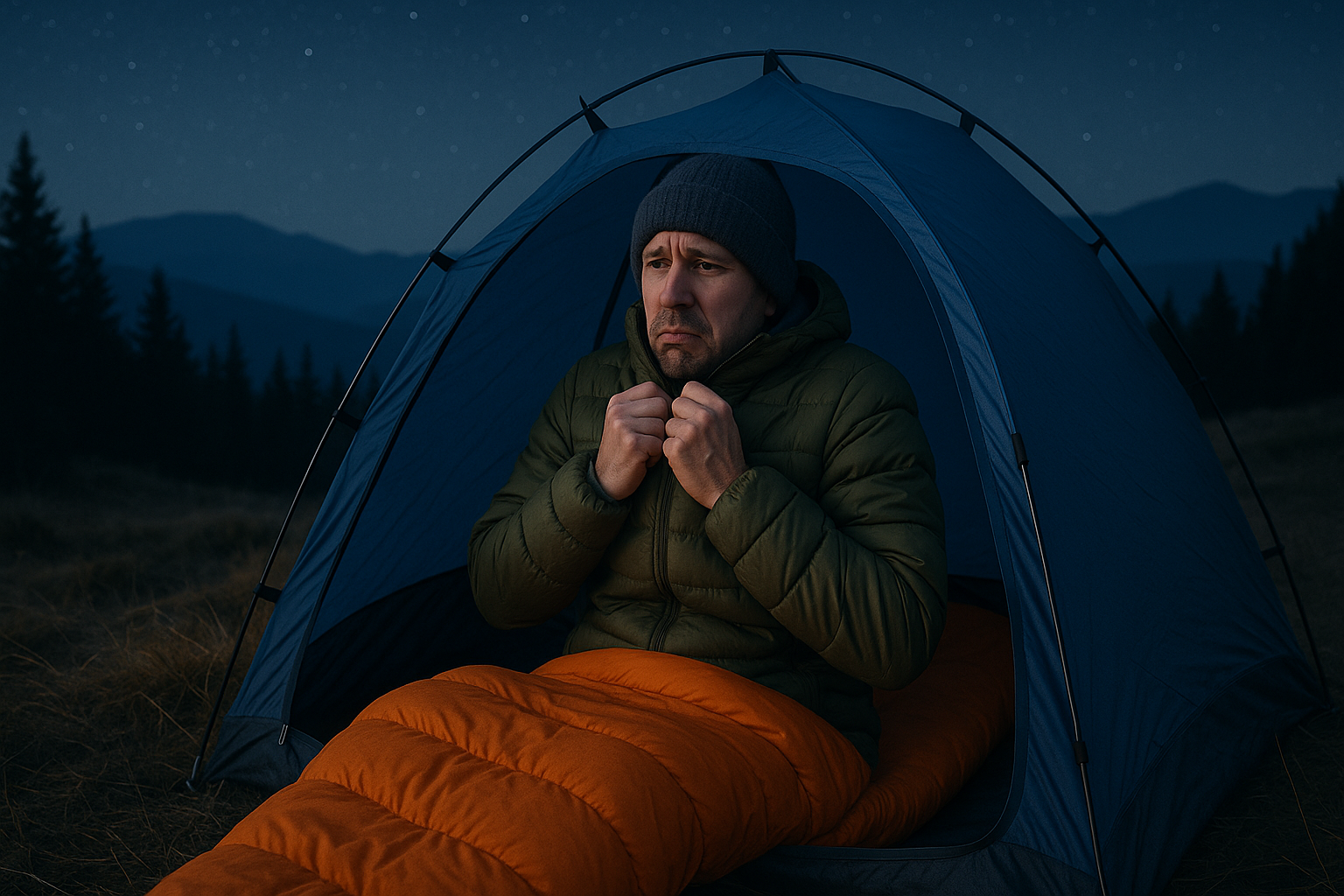As an Amazon Associate I earn from qualifying purchases.
You invested in a solid sleeping bag. The temperature rating matches the forecast. You crawled in early, zipped it tight, even wore your base layers. But by 3 a.m., you’re shivering. Again.
If this keeps happening on your backpacking or solo camping trips, you’re not imagining things. You’re not weak. And your sleeping bag isn’t broken.
You’re just missing one critical insulation layer.
Let’s unpack why “good enough” sleep systems still leave you cold—and how one overlooked ultralight item can make the difference between frozen misery and deep, restorative sleep.
Why You’re Cold (Even With a Quality Bag)
A sleeping bag’s rating is only part of the story. That 20°F or 30°F label doesn’t guarantee comfort—it’s based on:
- Lab tests in still air
- Proper insulation underneath (pad or ground)
- Full zip and hood use
- Wearing base layers
And even then? It reflects a survival rating, not a comfort one.
But that’s not the only issue. Cold sleep is often due to what’s missing from your insulation stack—not what’s wrong with your sleeping bag.
Let’s zoom in.
The Missing Link: The Sleep System “Shell”
What most ultralight hikers and solo campers skip isn’t warmth inside the bag—it’s heat loss from outside. Wind, condensation, and radiant cold from the ground all steal heat—even through your pad and quilt.
What’s missing?
🔥 An insulated shell or over-bag layer.
Just like your body needs a jacket over a fleece, your sleep system needs a protective shell to trap heat and block environmental chill.
This can be a bivy, sleeping bag liner, thermal blanket, or insulated quilt layer. And it’s the most overlooked part of cold-weather or shoulder-season setups.
Let’s Break Down the Smartest Lightweight “Shell” Additions
1. Thermal Sleeping Bag Liners (4–9 oz)
Best For:
Boosting your bag’s warmth rating without buying a whole new bag.
A thermal liner slips inside your existing bag, adding up to 10–15°F of warmth for minimal weight. Choose ones made of:
- Thermolite
- Fleece (for car camping or very cold nights)
- Silk (lightest option, adds ~5°F)
Pros:
- Adds warmth directly around your body
- Keeps bag cleaner (fewer washes = longer bag life)
- Packs down tiny
Sea to Summit Reactor Sleeping Bag Liner, Extreme Compact (78 x 31.5)
- Insulated sleeping bag liner adds extra warmth and personal hygiene to any sleeping bag.
- Thermolite Pro technology using knitted, hollow-core fibers and absorbing infrared ceramic pigments to reflect your body’s heat back to the wearer for enhanced warmth and comfort
- Drawcord footbox can be opened or closed for optimal comfort and integrates perfectly with the footbox of our Free-Flow Zip system in select Sea to Summit sleeping bags
List Price :
Offer: 71.83
Go to Amazon2. Ultralight Bivy Sacks (6–10 oz)
Best For:
Blocking wind and condensation in exposed setups or tarp camping.
A bivy sack wraps around your sleeping bag like a shell jacket—trapping warmth and shielding from drafts or light rain.
Look for:
- Water-resistant but breathable material (Pertex, Gore Windstopper)
- Side zip or full zipper access
- Condensation-resistant liner
Outdoor Research Helium Bivy, Coyote, One Size
- LIGHTWEIGHT & BREATHABLE: Be prepared for a night of adventure by carrying this lightweight sleeping bag. Made of a combination of nylon, TPU, and polyester, this helium bivy is waterproof, breathable, and easy to carry and use.
- LIGHTWEIGHT & BREATHABLE: Be prepared for a night of adventure by carrying this lightweight sleeping bag. Made of a combination of nylon, TPU, and polyester, this helium bivy is waterproof, breathable, and easy to carry and use.
- DURABLE AND BREATHABLE: This Outdoor Research bivy features a fully seam-taped construction that adds durability to it. Its clamshell opening makes it the perfect bivy tent for fast and light missions.
New starting from: 224.95
Go to Amazon3. Reflective Emergency Blankets (2–4 oz)
Best For:
Budget warmth boost or emergency wind block.
These are not just for survival kits. Use them under your pad or around your sleeping bag to reflect radiant heat back to your body.
How to use:
- Line the floor of your tent or under bivy
- Wrap around the bag loosely to trap air
- Avoid direct contact to prevent sweat buildup
💡 Pro tip: Use duct tape or mini clips to secure it without rustling.
S.O.L. Survive Outdoors Longer 90% Heat Reflective Heavy-Duty Emergency Blanket – Thick, Rugged for Disaster Preparedness Kit – Waterproof, Windproof, Tear-Resistant – 58" x 98", 3.2 oz, Green
- Compact Heat Retention: This heat reflective blanket, at 58 x 98 inches, is ideal for any survival kit and is 2x stronger than traditional emergency blankets, offering versatility and warmth in emergencies
- Durable SOL Survival Blanket: Our vacuum-metalized polyethylene rescue blanket resists punctures, doubling as a ground tarp, emergency shelter, gear cover, and more
- Weatherproof Shelter: As part of your emergency gear, this waterproof, windproof, and tearproof blanket provides reliable refuge from the elements
New starting from: 15.99
Go to Amazon4. Top Quilt + Sleeping Bag Combo
Best For:
Sleepers who toss and turn or have cold-sensitive torsos.
Adding a lightweight down top quilt over your regular bag creates a layer of trapped air and reduces convective heat loss—like throwing an extra blanket over a comforter.
Keep it under 16 oz to stay within ultralight goals.
Ultralight Sleeping Bag Top Quilt – 850 Fill Power Down Backpacking Blanket, 1.9 lbs, Rated for 20°F, Water-Resistant, Compact Camping Quilt for Outdoor Adventures
- Ultra-Lightweight: Weighing ONLY 1.9 lbs, this sleeping bag camping quilt is incredibly lightweight, making it perfect for backpacking and long hikes. It won’t weigh you down, so you can carry it easily without sacrificing warmth or comfort.
- 850 Down Fill: Packed with premium 850-fill power down, this quilt offers exceptional warmth while remaining lightweight. The down fill provides a superior warmth-to-weight ratio, ensuring you stay cozy without the bulk, even in colder conditions.
- PERKS of Top Quilt Sleeping Bag: More Versatility, Les Weight and Bulk, More Freedom of Movement, More Customization with use, Easier Entry and Exit, More Ventilation for temperature regulation as desired and Far Less Claustrophobic. No getting Twisted up in bag anymore. No more slipping off pad and pillow during the night.
New starting from: 114.95
Go to Amazon5. Ground Insulation: Underbody Cold is Real
Your sleeping bag compresses under you—meaning almost no insulation between you and the ground unless your pad makes up for it.
If you skimp on your pad, that cold is coming from below.
Fix it with:
- Foam sit pad under hips
- Reflective layer under sleeping pad
- Pairing foam + air pads (closed-cell foam + inflatable)
Even a 1 oz foam layer under your torso can fix the root of your chill.
HEST Foamy Short – Portable Camping Mattress, Enhanced Memory Foam, Short Single Mattress, 64" L X 25" W
- DESIGNED FOR ADVENTURE: The Foamy is the camping mattress you have been waiting for; maximal comfort & support that rivals your home mattress in a packable, portable adventure-ready form. We offer the foamy in 3 sizes to meet all types of dreamers’ sleeping preferences. The Foamy Short 64” x 25” x 3.9”, the Foamy 78″ x 25″ x 3.9” and the Foamy Wide is 78″ x 30″ x 3.9”.
- ENHANCED MEMORY FOAM: Our mattress is engineered for optimal body alignment, pressure point relief, and temperature regulation. Two layers of high-performance memory foam provide the most comfortable camping mattress or sleeping pad available
- OUTDOOR READY: Designed to roll with you on all your adventures, the Foamy’s integrated compression strap and durable, temperature resilient memory foam is ready for all kinds of camping in all kinds of conditions.
New starting from: 279.00
Go to AmazonReal-World Use Cases
❄️ Cold Desert Nights
Deserts drop to freezing. Wind + dry air = evaporative cooling. A bivy + liner setup adds critical heat protection without bulk.
🏔️ High-Altitude Alpine Trips
Cold seeps up from granite and seeps down from wind gusts. Reflective under-layers + quilt combo = double trap zone.
🍂 Shoulder Season or Early Spring
When temps swing wildly, layering options let you adapt night by night without upgrading your sleeping bag.
Bonus Tricks for Staying Warm
Even with a good shell layer, don’t forget these:
🔥 Eat a Snack Before Bed
Fuel your body for internal heat. Fat + carbs = slow-burning overnight fire.
🧦 Wear Dry Sleep Socks
Cold toes wake you up. Dedicated clean socks boost morale and insulation.
💨 Use a Buff to Seal Heat Gaps
Neck drafts lose heat fast. A fleece or merino buff closes the gap between face and bag.
🛏️ Sleep in a Beanie
Your head can lose up to 10% of body heat. Keep it in.
Final Thoughts: The Bag Isn’t the Problem
If you’ve upgraded your bag and still wake up cold, it’s not your fault. You’ve likely hit the limit of what a single-layer system can do.
Smart insulation is layered. Your clothing is. Your sleep system should be too.
That “one missing layer” is usually a shell or liner that traps air, blocks wind, or reflects body heat—and it only needs to weigh 2 to 10 ounces.
So before you spend $400 on a new bag, ask:
What am I missing outside the bag?
Because comfort at night isn’t about more down.
It’s about smarter insulation design.
✅ Quick Recap:
- Most sleeping bags don’t provide enough warmth on their own
- Add a shell layer: thermal liner, bivy sack, or reflective barrier
- Ground insulation is critical—layer under your pad or hips
- Consider layering a quilt over your bag for colder trips
- Small upgrades (buff, socks, snacks) boost overnight heat retention






